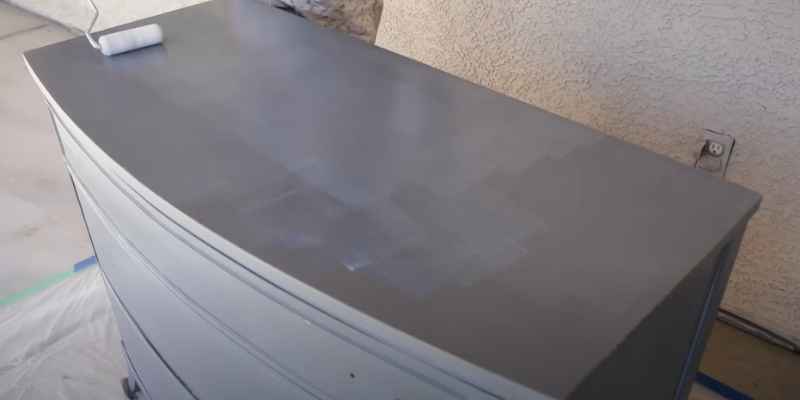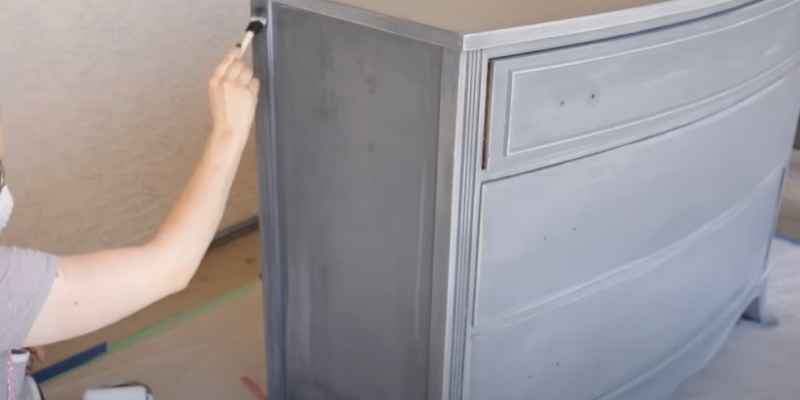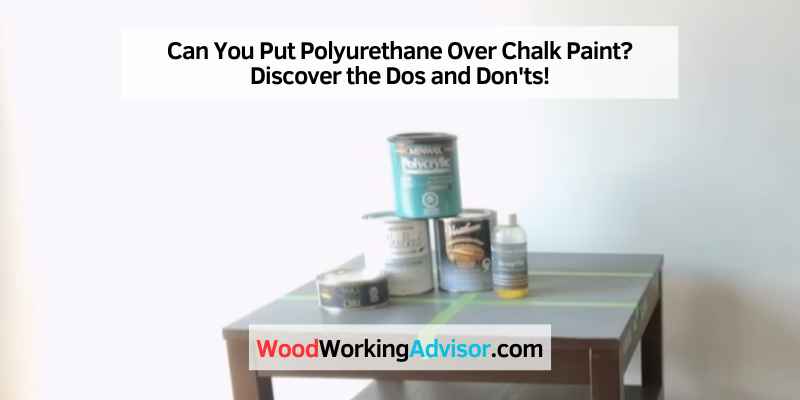Yes, you can apply polyurethane over chalk paint for added protection and durability. Chalk paint provides a matte finish, while polyurethane adds a protective layer and a glossy or satin sheen to the painted surface.
This combination can enhance the look of your painted furniture or decor items while providing extra durability. Polyurethane is a clear topcoat that can be applied over various painted surfaces, including chalk paint. It acts as a protective layer, providing added durability and a glossy or satin sheen to the painted surface.
Whether you have painted furniture, cabinets, or decorative items, applying polyurethane over chalk paint can enhance the look and provide long-lasting protection. We will discuss the process of applying polyurethane over chalk paint and the potential benefits it brings. So, read on to learn more about this popular finishing technique.
Can You Put Polyurethane Over Chalk Paint?
Applying a layer of polyurethane over chalk paint is a common question among DIY enthusiasts. While chalk paint provides a matte and vintage finish, some homeowners prefer the added protection and durability that polyurethane offers. In this article, we will explore whether it’s possible to put polyurethane over chalk paint and discuss the benefits and considerations you should keep in mind.
Benefits Of Polyurethane Over Chalk Paint
When applying polyurethane over chalk paint, you can enjoy several advantages:
- Enhanced Durability: The protective layer of polyurethane can help make your chalk-painted furniture or surfaces more resistant to scratches, scuffs, and general wear and tear.
- Water Resistance: Polyurethane is known for its water-resistant properties, making it an excellent choice for areas prone to spills or high humidity. This additional layer creates a barrier that protects your chalk-painted surface from moisture damage.
- Glossy Finish: If you desire a glossy or semi-glossy finish instead of the matte look of chalk paint, polyurethane can provide the sheen you’re looking for.
- Easy Maintenance: Polyurethane is relatively easy to clean and maintain. With a simple wipe-down, you can keep your surfaces looking fresh and vibrant.
Considerations Before Applying Polyurethane Over Chalk Paint
Before you decide to put polyurethane over chalk paint, consider the following:
- Compatibility: Ensure that the polyurethane you’re using is compatible with chalk paint. Some types of polyurethane may create unwanted reactions, such as yellowing or adhesion issues, so it’s crucial to test a small inconspicuous area before applying it to the entire surface.
- Surface Preparation: Properly prepare your chalk-painted surface before applying polyurethane. Make sure the paint is fully cured and dried, then clean it thoroughly to ensure optimal adhesion.
- Application Technique: Apply polyurethane evenly and smoothly using a high-quality brush or foam applicator. Avoid over-brushing, as this can lead to streaks or an uneven finish.
- Drying Time: Allow the polyurethane to dry completely between coats and before using the furniture or surface. Follow the manufacturer’s instructions for recommended drying times.
- Future Touch-ups: Keep in mind that once you apply polyurethane over chalk paint, it may be challenging to make touch-ups or reapply chalk paint in the future. Consider whether you want to preserve the chalk paint’s ability to easily refurbish the surface.
By taking these considerations into account, you can make an informed decision about whether applying polyurethane over chalk paint is the right choice for your project. Remember, always test the compatibility and follow proper application techniques for the best results.

Dos For Applying Polyurethane Over Chalk Paint
When it comes to applying polyurethane over chalk paint, following the right dos is crucial for achieving a flawless and long-lasting finish. From proper surface preparation to choosing the right polyurethane and application techniques, each step plays a vital role in ensuring optimal results. In this section, we will explore the dos in detail to help you achieve a professional-looking finish with ease.
Proper Surface Preparation
Before applying polyurethane over chalk paint, it is essential to prepare the surface properly. This ensures good adhesion and minimizes any imperfections that may affect the final result. Here are the key steps to follow:
- Begin by cleaning the surface thoroughly with a gentle detergent to remove any dirt, grease, or grime. Rinse it well and allow it to dry completely.
- If you notice any loose or flaking paint, gently sand the surface to create a smooth and even base. Use a fine-grit sandpaper and remove any dust afterward.
- Check for any visible imperfections, such as nicks, dents, or scratches, and fill them with an appropriate wood filler or spackling compound. Ensure to sand the filled areas for a seamless finish.
- Wipe the surface with a tack cloth or microfiber cloth to remove any residual dust particles and ensure a clean surface for painting.
Choosing The Right Polyurethane
Choosing the right polyurethane is crucial for both the protection and aesthetic appeal of your chalk paint project. Consider the following factors when selecting your polyurethane:
- Finishing type: Decide whether you want a glossy, satin, or matte finish based on your aesthetic preferences. Each type of polyurethane provides a different level of sheen and durability.
- Water or oil-based: Consider the pros and cons of water-based and oil-based polyurethanes. Water-based options tend to dry faster and have a lower odor, while oil-based polyurethanes offer a more traditional finish and can provide better protection.
- Compatibility with chalk paint: Ensure that the polyurethane is compatible with chalk paint. Look for options specifically designed for this purpose to achieve optimal adhesion and durability.
Application Techniques
Applying polyurethane over chalk paint requires the right technique to achieve a smooth and even finish. Consider the following tips for successful application:
- Use a quality brush or roller: Invest in a high-quality brush or roller designed for polyurethane applications. This will help ensure smooth application and reduce the chances of streaks or brush marks.
- Apply thin coats: It is better to apply multiple thin coats of polyurethane rather than a single heavy coat. This allows for better control and reduces the risk of drips or pooling.
- Follow the drying and sanding guidelines: Allow each coat to dry completely as per the manufacturer’s instructions. Lightly sand the surface between coats using fine-grit sandpaper to promote adhesion and create a smooth finish.
- Protect the surrounding areas: Cover any areas or objects that you don’t want to be exposed to polyurethane, such as floors or furniture. Use painter’s tape and drop cloths to ensure clean and protected surroundings.

Don’ts When Applying Polyurethane Over Chalk Paint
When it comes to applying polyurethane over chalk paint, there are certain things you must avoid to ensure a successful and long-lasting finish. Here are some common mistakes you should steer clear of:
Skip Surface Preparation
Surface preparation is a crucial step before applying polyurethane over chalk paint. Without proper preparation, the polyurethane may not adhere well to the surface and may result in peeling or bubbling. To avoid this, make sure the chalk paint is completely dry and cured before proceeding. Clean the surface thoroughly to remove any dust or debris, and consider using a light sandpaper to create a smooth and even surface.
Use The Wrong Type Of Polyurethane
Using the wrong type of polyurethane can also lead to unsatisfactory results. Not all polyurethane products are compatible with chalk paint, so it’s essential to choose the right one. Water-based polyurethane is generally recommended for use over chalk paint, as it dries clear and has a low odor. Oil-based polyurethane may cause the chalk paint to yellow over time. Be sure to read the product labels and select a polyurethane that is specifically designed for use over painted surfaces.
Apply Too Many Coats
While it may be tempting to apply multiple coats of polyurethane for added durability, it’s important to exercise restraint. Applying too many coats can lead to a thick and uneven finish, which can detract from the natural beauty of the chalk paint. Additionally, excessive coats can increase the drying time and make the surface prone to scratches and scuffs. Follow the manufacturer’s instructions and apply the recommended number of coats for optimal results.
By avoiding these common mistakes, you can ensure a smooth and flawless finish when applying polyurethane over chalk paint. Remember to prepare the surface properly, choose the right type of polyurethane, and apply a reasonable number of coats. With the right approach, your chalk painted furniture or surfaces will retain their beauty and durability for years to come.
Conclusion
To conclude, applying polyurethane over chalk paint is possible and can provide added durability and protection to your projects. However, it is crucial to properly prepare the surface by cleaning and lightly sanding before applying the polyurethane. Additionally, choose a water-based polyurethane for a smoother finish.
Remember to always test on a small area first to ensure compatibility and desired results. Embrace this technique to achieve a lasting and beautiful finish on your chalk paint projects.


